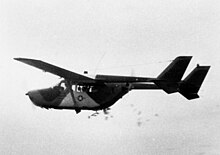Forward Air Controller
A Forward Air Controller ( FAC ; German air traffic control officer ) directs the use of combat aircraft in close air support missions ( CAS) in the immediate vicinity of the battle ( advanced ) or from a command post .
history
The German Wehrmacht used so-called Stukaleit officers in World War II . These were used directly by the combat troops , mostly at battalion level , and maintained direct radio communication with the "Stukas" . The Stukaleit officers were mostly experienced pilots themselves and were able to assess the situation on the ground from the perspective of a pilot, so both spoke “the same language”. In this way, information about targets, own tips, dangers from flak or similar and suitable ammunition could be transmitted promptly.
During their deployment in North Africa from 1942 to 1943, the British Desert Air Force (DAF), together with the US tactical units of the United States Middle East Air Force (USMEAF), developed an effective method of direct support for ground units as they advance against enemy positions. The fighter pilot, who had to be an officer of the Royal Air Force, moved in the front line together with the advancing ground units. This “Air Liasion Officer” (ALO) of the RAF , who judged the fight from the ground with the eyes of a pilot , was in direct contact with the pilots of approaching fighter planes via VHF radio. He passed on all information relevant to the air attack in compact form to his comrades in the air, such as the position of anti-aircraft guns, the exact location and marking of the targets and any terrain characteristics. After the air strike, the FAC assessed the impact of the attack and, under certain circumstances, suggested repeating the attack on missed targets. To this end, more combat aircraft in the hinterland is held in a so-called taxi queue (Engl. Cab rank ) ready to zoom fly when needed and attack.
In the air war during Operation Overlord in 1944, this method has been improved and contributed to the successful advancement of General George Patton's army in France.
Airborne FAC
During the Vietnam War , pilots were used as Forward Air Controllers, so-called ABFAC (Airborne Forward Air Controller). These mainly used the Cessna O-1 Bird Dog , Cessna O-2 Skymaster, and North American OV-10 Bronco .
Use in the present
The Forward Air Controller has the following equipment:
- Radio equipment (V / UHF; zbURC-200)
- Data processing system
- GPS navigation system
- Laser target markers
- Infrared marker
- Night vision devices
- Laser rangefinder (e.g. Leica Vector IV)
- Video downlink systems; z. B. ROVER, Rosetta FireStorm; to receive image / video transmissions from the aircraft
Among other things, the FAC passes on the following information to the aircraft crews:
- Type of target (tank, bunker, etc.)
- exact location of the destination (coordinates; height above sea level)
- Type of marking of the target
- Position of your own troops or their direction and distance from the target
- Probably suitable or required ammunition
- recommended or required direction of approach to the target
The term Tactical Air Control Party (TACP) refers to an air control group consisting of FAC and support staff.
Web links
- History of the FAC
- FAC training in France (French, status: 09/2011) and report on Franco-German cooperation (French, status: 12/2013)
- Online dictionary of the Internet portal of the German Air Force
literature
- Gary Robert Lester, Mosquitoes to Wolves: The Evolution of the Airborne Forward Air Controller , 1997, ISBN 1-58566-033-7


